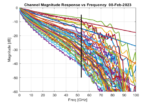Dan is joined by Suk Lee, Vice President of Design Ecosystem Development at Intel Foundry Services. He has over 35 years of experience in the semiconductor industry, with engineering, marketing, and general management positions at LSI Logic, Cadence, TI, Magma Design Automation and TSMC. At TSMC, he was responsible for managing… Read More
Are you developing or thinking about developing your own RISC-V processor? You’re not alone. The use of the RISC-V ISA to develop processors for SoCs is a growing trend. RISC-V offers a lot of flexibility with the ability to customize or create ISA and microarchitectural extensions to differentiate your design no matter your application… Read More
Modern day chips are increasingly complex with stringent quality requirements, very demanding performance requirement and very low power consumption requirement. Verification of these chips is very time consuming and accounts for approximately 70% of the simulation workload on EDA server farms. As software-based simulators… Read More
The semiconductor industry has seen a significant shift towards vertical integration of products, expanding from chips to generalized or purpose-built integrated solutions. As software becomes an increasingly critical component of these solutions, leveraging modern software development processes with User Experience… Read More
During the design of complex chips, cost reduction is becoming a real challenge for small, medium and large companies. Resource management is a key to contain design cost.
The chip design market is expecting automated solutions to help in the resource prediction, planning and analysis. AI-based technologies are promising … Read More
This is a special edition of our podcast series. At the recent Synopsys SNUG User Group, SemiWiki staff writer Kalar Rajendiran got the opportunity to conduct an informal interview with Aart de Geus, Chairman and CEO of Synopsys.
What follows are some of Aart’s thoughts on the deployment of AI across the semiconductor … Read More
Multiphysics simulation is the process of computational methods to model and analyze a system to understand its response to different physical interactions like heat transfer, electromagnetic fields, and mechanical structures. Using this technique, designers can generate physics-based models and analyze the behavior… Read More
The increasing demands for massive amounts of data are driving high-performance computing (HPC) to advance the pace in the High-speed Ethernet world. This in turn, is increasing the levels of complexity when designing networking SoCs like switches, retimers, and pluggable modules. This growth is accelerating the need for … Read More
Dan is joined by Mark Williams. Mark is a Founder and Chief Executive Officer at Pulsic. He has over 30 years of experience in the EDA industry and was one of the team that pioneered shape-based routing technology in the 1980s while working at Zuken-Redac.
Mark explains the unique “freemium” model for automating analog… Read More
Synopsys pulled out all the stops for this event. I attended the first full day, tightly scripted from Aart’s keynote kick off to 1×1 interviews with Synopsys executives to a fireside chat between Sassine Ghazi (President and COO) and Rob Aitken (ex-Fellow at Arm, now Distinguished Architect at Synopsys). That’s a lot of … Read More













Quantum Computing Technologies and Challenges